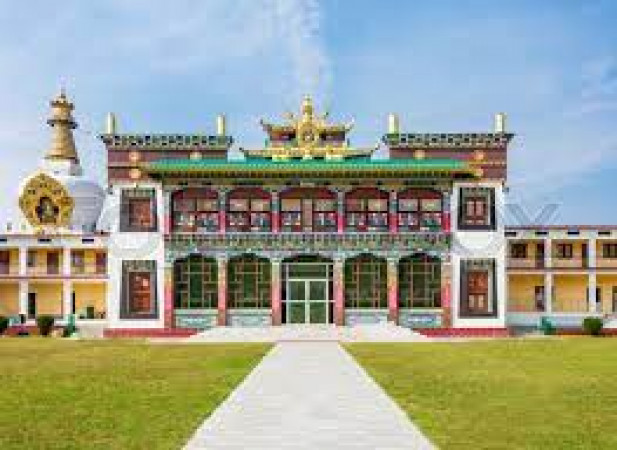
Mindrolling Monastery
Dehradun . Uttarakhand . India
Duration
1 to 2 Days
1 to 2 Days
Best time to visit
Mar-May, Oct-Nov
Mar-May, Oct-Nov
Theme
Religious, Heritage
Religious, Heritage
Mindrolling Monastery Travel Guide
Located in Dehradun, India, Mindrolling Monastery is a significant Tibetan Buddhist monastery known for its rich history and cultural heritage. Established in the 17th century, the monastery holds great religious importance and is a symbol of peace and spirituality. The stunning architecture and intricate designs of the monastery attract visitors from all over the world. Mindrolling Monastery is famous for its towering stupa, which is one of the tallest in Asia, and its vibrant festivals celebrating Buddhist traditions.Top Attractions in Mindrolling Monastery
- The Great Stupa
- Golden Temple
- Japanese Garden
- Scripture Centre
- Monastic University
Mindrolling Monastery is Famous for
Its towering stupa and vibrant Buddhist festivals.Top Attractions in Mindrolling Monastery
- Explore the Great Stupa
- Visit the Golden Temple
- Enjoy the tranquility of the Japanese Garden
- Discover ancient scriptures at the Scripture Centre
- Experience the monastic life at the Monastic University
What's Great about Travelling to Mindrolling Monastery?
- Peaceful and spiritual atmosphere - Rich cultural experience - Ideal for history and architecture enthusiastsWhat's Not So Great about Travelling to Mindrolling Monastery?
- Limited dining options - Limited accommodation choices - Limited transportation options within the areaTravel Tips for Mindrolling Monastery
- Respect local customs and traditions
- Carry sufficient cash as ATMs may be limited
- Dress modestly when visiting religious sites
- Plan your visit during the annual festivals for a cultural experience
Important Mindrolling Monastery trip information
- Ideal Duration: 2-3 days
- Best Time to Visit: March to June for pleasant weather
- Nearby Airports and Railway Stations: Jolly Grant Airport and Dehradun Railway Station
FAQ's on Mindrolling Monastery
Q1: What is the best time to visit Mindrolling Monastery?
The best time to visit Mindrolling Monastery is during the months of October to March when the weather is pleasant and ideal for exploring. This period also coincides with various festivals and events at the monastery, offering a rich cultural experience for visitors. The tourist season is less crowded during these months, allowing for a more serene and immersive visit.
Q2: Do I need a visa to travel to Mindrolling Monastery?
Tourists traveling to Mindrolling Monastery may require a tourist visa, depending on their nationality. It is advisable to check with the respective embassy or consulate for specific visa requirements. Some countries may be exempt from visa requirements or eligible for visa-on-arrival facilities. Make sure to have your travel documents in order before planning your trip.
Q3: What are the must-visit attractions in Mindrolling Monastery?
Mindrolling Monastery offers a wealth of attractions for visitors, including the Great Stupa, the serene gardens, the impressive prayer halls, and the intricate Tibetan architecture. Don't miss the opportunity to witness the daily rituals and ceremonies performed by the monks. The monastery's museum also houses a remarkable collection of Buddhist artifacts and manuscripts.
Q4: Is Mindrolling Monastery a safe place to travel?
Mindrolling Monastery is generally considered a safe destination for travelers. However, like any other place, it is advisable to be cautious and aware of your surroundings. Avoid venturing into isolated areas alone, especially at night. It's recommended to follow basic safety precautions, such as keeping your belongings secure and being mindful of local customs and traditions.
Q5: What is the local currency in Mindrolling Monastery and can I use credit cards?
The local currency in Mindrolling Monastery is the Tibetan currency. While credit cards may not be widely accepted in the monastery, there are ATMs available in nearby towns where you can withdraw cash. It's advisable to carry sufficient local currency for your expenses within the monastery premises.
Q6: What is the local cuisine like in Mindrolling Monastery?
The local cuisine in Mindrolling Monastery is predominantly Tibetan, offering a unique blend of flavors and spices. Some popular dishes include momos (dumplings), thukpa (noodle soup), and butter tea. Vegetarian options are also available for those with dietary preferences. Visitors can savor these traditional dishes at local eateries both within and around the monastery.
Q7: What transportation options are available in Mindrolling Monastery?
Transportation options in Mindrolling Monastery include local buses, taxis, and private car rentals. Public transport may be limited, so taxis or rental services are recommended for ease of travel within the region. It's advisable to arrange transportation in advance for visiting nearby attractions or exploring the surrounding areas.
Q8: Are there any cultural norms or etiquette I should be aware of when visiting Mindrolling Monastery?
When visiting Mindrolling Monastery, it's important to respect the local customs and traditions. Dress modestly and remove your shoes before entering any prayer halls or sacred spaces. Avoid pointing your feet towards religious objects or individuals and seek permission before taking photographs. It's also customary to greet monks with a respectful bow. By being mindful of these cultural norms, you can enhance your experience and show reverence to the monastery's spiritual significance.
Q9: I am a travel agent. How can I buy travel leads of Mindrolling Monastery?
Register yourself as a travel agent at agents.tripclap.com and then you can buy travel leads to Mindrolling Monastery once your account is approved. For more details contact our support team at +91-8069186564 or support@tripclap.com
